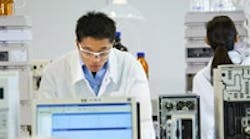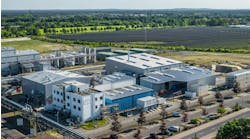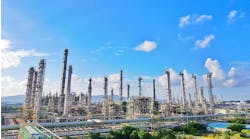MULTIFACETED APPROACH
Figure 1. BASF researchers complement their experimental work by modeling underlying physico-chemical processes. Source: BASF.
“There are usually many possible options to improve energy efficiency. For example, increasing yield by using an improved catalyst will, in general, reduce the effort of recycling unconverted educts [reactants] or separating unwanted byproducts. Another possibility is to optimize and compare different process concepts in terms of energy efficiency. For a sustainable process development, the whole process has always to be considered,” the spokesman notes.New or improved catalysts and polymer processes are two of the key areas of interest to the company; one of the commercial tools BASF uses is gPROMS Advanced Process Modeling from
Process Systems Enterprise, London, U.K., a package specially designed to handle the difficult requirements of batch and semi-batch systems.In one project, BASF used the software to build a high-fidelity detailed kinetic model of its batch expanded polystyrene process and then applied dynamic optimization techniques. The first-principles gPROMS batch process model included detailed reaction kinetics, with parameters estimated from experimental data. It modeled heat and material balances, geometry details, transport and thermodynamic properties, and plant operating procedures. BASF then used dynamic optimization to minimize batch time, taking into account process constraints. The company identified a 30% reduction in batch time, which, of course, provides energy savings.
SPOTTING POTENTIAL SAVINGS AspenTech starts by running simple profitability models to discover energy-saving opportunities. Steady-state and dynamic modeling assess the demand side and Aspen Utilities Planner evaluates the supply side. “These can be models of either facilities or operations, and we typically find that in a large plant you can improve energy efficiency by 10–25%,” Beck says.However, one challenge with turning these opportunities into reality is the lack of in-house skills on modeling software — a legacy of management consultancies convincing chemical operating companies to outsource their engineering competencies, he notes.For success, the models must be up-to-date and thoroughly understood by users.For this reason, AspenTech has set up a small consulting group to help operating companies. This group typically identifies at a large site 50–100 projects to improve energy efficiency, ranging from no-investment supply-side initiatives to ones requiring large capital investment.A recent project at LG Chem’s Yeosu plant in South Korea illustrates the value of simulation technology. Here, management was charged with exploring reconfigurations to increase 1,3 butadiene production capacity and improve energy performance. Adding to the challenge, any process revamps couldn’t involve major upgrades or replacements.LG Chem used Aspen Plus to develop detailed simulation models of the plant and employed the integrated Aspen Exchanger Design and Rating models to assess existing process equipment to determine available spare capacity. Using the simulation models, LG Chem successfully developed methods to debottleneck both the extractive distillation column and fractionator — resulting in spare production capacity increases of 13% and 17%, respectively. Overall, the plant could achieve 15% greater capacity with only a small additional capital investment. Similarly, the detailed heat integration of process streams produced by Aspen Energy Analyzer showed that rearranging the path of a solvent stream loop would enable the energy in the loop to be recovered and used for heating purposes elsewhere in the process. Moreover, this energy recovery decreased the final temperature of the stream before it went to a final cooler to 51°C from 70°C, which ultimately reduced the required quantity of cold utility in the cooler. In addition, identification of a new use for steam in the process eliminated excessive steam venting.The company now is utilizing AspenTech products to simulate, monitor and optimize plant performance at other sites.AkzoNobel’s Deventer site in the Netherlands relies on Aspen Plus for modeling unit operations and plants. “This tool provides us with a broad application in both R&D and process engineering, as it combines simulation of unit operations, total plant simulation, process dynamics, and heat integration studies — combined with solid physical property sets to do trustful calculations,” says Jacky Oonincx, leader of the process technology expert capability group at Deventer. Modeling is important as the company strives to meet its strategic targets to improve energy efficiency and reduce carbon dioxide emissions, such as a goal ofcutting the cradle-to-grave carbon footprint per ton of sales by 25–30% from 2012 to 2020. “To achieve this target, we use the best available know-how; this sometimes means ensuring existing best practices are in place but for more distinctive, complicated processes we use modeling software. We see modeling as a strong enabler to achieve our broader energy efficiency improvement target. For example, for new breakthrough processes that replace existing processes, we aim for a 30–40% energy reduction in combination with reduced capital investments. For the optimization of existing processes, we focus on the processes with high energy consumption,” she says.
DME INITIATIVEA good example of this in action is a study of novel manufacturing routes for dimethyl ether (DME) jointly carried out by
AkzoNobel’s Deventer R&D department;the Ecole Nationale Supérieure de Chimie de Mulhouse, Mulhouse, France;and the department of chemical engineering at the University Politehnica of Bucharest, Romania.The increasing use of DME as a clean fuel and green aerosol propellant is spurring efforts to achieve higher production rates at lower production costs. Traditionally, high purity DME is synthesized by dehydration of methanol produced from syngas in a conventional gas-phase process that involves a catalytic fixed-bed reactor followed by two distillation columns. The main problems with this process are the high investment costs for units such as the reactor, columns and heat exchangers, the large overall plant footprint they require, and their heavy energy use. To tackle these problems, the three organizations investigated novel process-intensification alternatives based on a dividing-wall column (DWC) or reactive distillation (RD). These promise a smaller footprint and significant savings in both investment and operating costs. These process-intensification alternatives were rigorously simulated in Aspen Plus.The study showed that both DWC and RD technology can serve effectively to improve existing and new DME processes. For example, a single-step separation based on DWC can replace the conventional DME purification and methanol recovery distillation sequence. The proposed DWC alternative reduces energy requirements by 28% and equipment costs by 20% compared to the conventional direct sequence of two distillation columns.Moreover, the study found RD to be a feasible process-intensification alternative to produce DME by methanol dehydration using solid acid catalysts. “The innovative reactive DWC (R-DWC) process (
Figure 2) resulted in energy savings of up to 60% and significantly lower investment costs compared to the existing process,” notes Oonincx.





